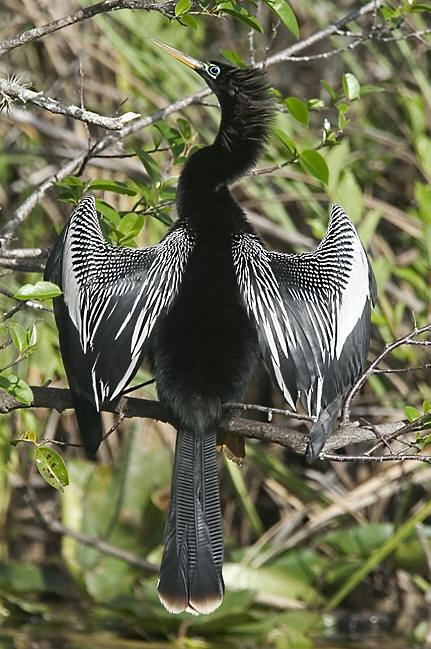
Anhingas have to let their wings dry. Also, being underwater makes them lose heat even faster than normal. The bird uses its webbed feet to perch on a limb, spread its wings and warm up.
(Photo credit: www.usefilm.com)
Fish Kebabs
You’re an anhinga and it’s past your lunchtime. What will you do? You go for a swim underwater to decide which unlucky fish is going to be on the menu today. There’s a tasty-looking fish just ahead, so you stretch out your neck and spear the fish! Lunch is now served.
Anhingas are funny-looking critters that measure almost three feet long. They are sometimes called snakebirds because of the small head and long, curved neck. When the bird is swimming, it bends its neck into a Z shape. When the time is right, the anhinga uses its sharp bill like a dagger to stab its prey.
An unusual fact about the anhinga is that it swims and flies quickly. Most other diving birds can’t do both of those equally well.
Like us humans, these birds have to dry off after getting wet. They don’t have waterproof feathers, so if you see one perched on a branch, there’s a good chance the bird was just in the water.
Suppose you see a snakebird spreading its wings. You might guess that it was doing this as another way to dry the wings. But ornithologists--scientists who study birds--say that anhingas lose heat faster than other birds, so wing-spreading helps absorb sunlight.

Anhingas have to let their wings dry. Also, being underwater makes them lose
heat even faster than normal. The bird uses its webbed feet to perch on a limb,
spread its wings and warm up.
(Photo credit: www.usefilm.com)
Are you a birdwatcher? A lot of people are, but most probably haven’t seen an anhinga. Warm, tropical places are a good place to look if you’d like to see the bird. Sometimes they are found in states like North and South Carolina, Missouri and Arizona.
Another topic that people are interested in is how birds build their nests. They use nests because they can’t afford a real house, and what would a bird do with a doorbell anyway? Like other birds, anhingas use objects like sticks and grass as building materials. Usually the nest is built in a small tree or in a bush near a swamp, stream or river. Also, you can often find that an anhinga family’s “home” has a lot of neighbors living nearby, including herons and egrets.
For the male anhinga, building the nest is part of how he tries to attract a “wife.” After he has built her a nice house, he then shows off, trying to look good. A male will stand up and extend his neck and tail feathers. He will spread his wings and twist his neck into a curved shape. If the female is attracted to him, the two start acting romantic, rubbing bills and gently nipping each other.
You’re lucky if you get to see this bird showing off. You’d usually just see the male’s black and shiny green colors, but if he’s hoping to attract a female, you’ll see him displaying all his silver feathers. The female is mostly black except for her brown neck and head.

Many
birds, including the anhinga, clean themselves with their bill. This is what
ornithologists call preening. It’s about the same as combing your hair and
making yourself look nice.
(Photo credit: www.usefilm.com)
The female usually lays two to five light blue eggs. After the female anhinga lays the eggs, it will take a few weeks for the babies to hatch. During this time, both the “husband” and “wife” take care of these and take turns keeping them warm. Like many young, the babies can’t do much for a while other than ask to bed fed. They’ll grow up soon enough, though, and learn to fly and go fishing.
If you’re watching birds and finding out more about them, you’ll want to know that these birds are closely related to another family of fish-eating birds called cormorants. Here is a simple way to tell them apart: a cormorant’s bill is hooked, not pointed. Look at the necks, too: the anhinga's is longer and S-shaped. Take the time to watch this interesting bird; just keep your distance. If you get hungry for fish, get your own!